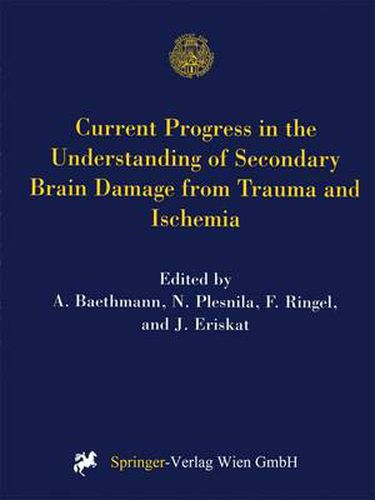Readings Newsletter
Become a Readings Member to make your shopping experience even easier.
Sign in or sign up for free!
You’re not far away from qualifying for FREE standard shipping within Australia
You’ve qualified for FREE standard shipping within Australia
The cart is loading…






This title is printed to order. This book may have been self-published. If so, we cannot guarantee the quality of the content. In the main most books will have gone through the editing process however some may not. We therefore suggest that you be aware of this before ordering this book. If in doubt check either the author or publisher’s details as we are unable to accept any returns unless they are faulty. Please contact us if you have any questions.
Information is provided from the basic and clinical sciences on the mechanisms damaging the brain from trauma or ischemia. New aspects involve the endoplasmic reticulum, mitochondrial failure, pathobiology of axonal injury, molecular signals activating glial elements, or the emerging therapeutical role of neurotrophins. Experimental issues involve a better analysis of the ischemic penumbra, the salvagable tissue. Therapeutic contributions reach from the environmental influence to gene expression, including neuroprotection, such as hibernation - mother nature’s experiment - or hypothermia which is reported to induce cell swelling. Treatment issues deal also with thrombolysis and combination therapies, or with the clearance of adverse blood components - LDL/fibrinogen - by a novel procedure using heparin. Other highlights are discussing the specificities of pediatric vs. adult brain trauma, or the evolving role of the Apolipoprotein-E e4 gene in severe head injury. An update is also provided on an online assessment of the patient management during the pre- and early hospital phase in Southern Bavaria. The empirical observation of neuroworsening is analyzed in further details, whether this is a specificity autonomously driving the posttraumatic course. Finally, the unsolved question why drug trials in severe head injury have failed so far in view of the promising evidence from the laboratory is subjected to an expert analysis.
$9.00 standard shipping within Australia
FREE standard shipping within Australia for orders over $100.00
Express & International shipping calculated at checkout
This title is printed to order. This book may have been self-published. If so, we cannot guarantee the quality of the content. In the main most books will have gone through the editing process however some may not. We therefore suggest that you be aware of this before ordering this book. If in doubt check either the author or publisher’s details as we are unable to accept any returns unless they are faulty. Please contact us if you have any questions.
Information is provided from the basic and clinical sciences on the mechanisms damaging the brain from trauma or ischemia. New aspects involve the endoplasmic reticulum, mitochondrial failure, pathobiology of axonal injury, molecular signals activating glial elements, or the emerging therapeutical role of neurotrophins. Experimental issues involve a better analysis of the ischemic penumbra, the salvagable tissue. Therapeutic contributions reach from the environmental influence to gene expression, including neuroprotection, such as hibernation - mother nature’s experiment - or hypothermia which is reported to induce cell swelling. Treatment issues deal also with thrombolysis and combination therapies, or with the clearance of adverse blood components - LDL/fibrinogen - by a novel procedure using heparin. Other highlights are discussing the specificities of pediatric vs. adult brain trauma, or the evolving role of the Apolipoprotein-E e4 gene in severe head injury. An update is also provided on an online assessment of the patient management during the pre- and early hospital phase in Southern Bavaria. The empirical observation of neuroworsening is analyzed in further details, whether this is a specificity autonomously driving the posttraumatic course. Finally, the unsolved question why drug trials in severe head injury have failed so far in view of the promising evidence from the laboratory is subjected to an expert analysis.